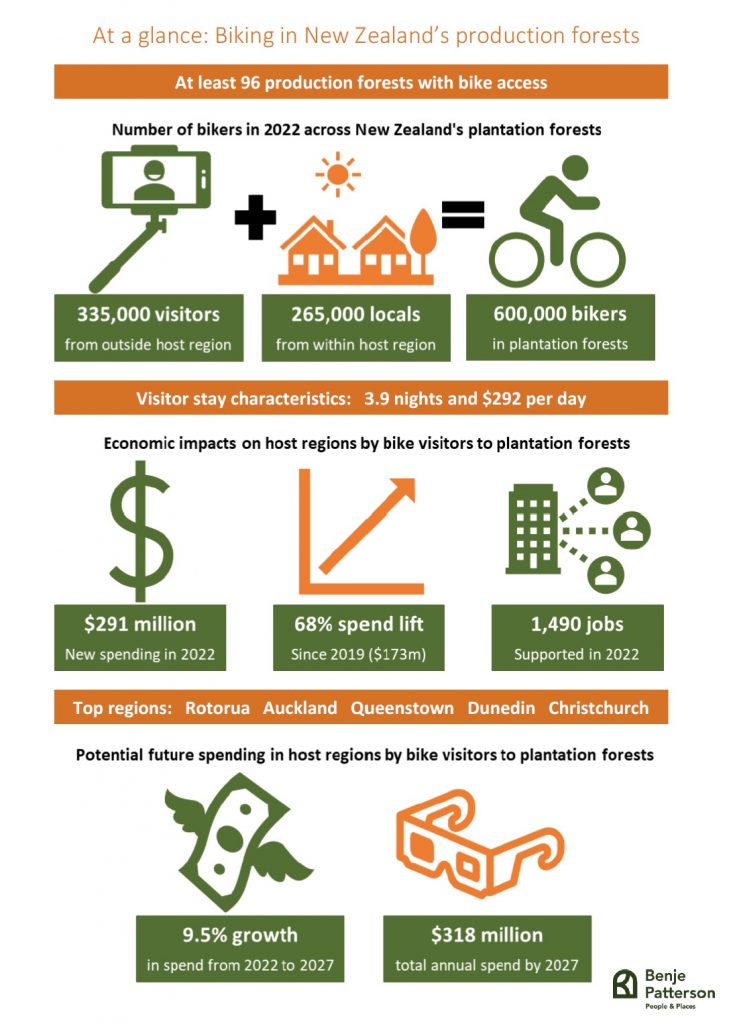23 May 2023
Media release for immediate use – Bike tourism in production forests worth $291 million
At least $291 million was spent by bike tourists who cycled through New Zealand’s production plantation forests in 2022, shows a new report by economist Benje Patterson.
“Many people will be aware that New Zealand’s timber and log exports are huge, but most people wouldn’t realise that recreational bike access to forests is also a key element of regional visitor economies,” said Mr Patterson.
“What’s more spending associated with bike tourists to plantation forests has grown by two thirds since before Covid-19,” he said.
“To put the estimate of $291 million of spending by bike visitors to production forests in perspective – total spending by visitors along the New Zealand Cycle Trail network was estimated at $951 million in 2021,” continued Mr Patterson.
And it’s not just visitors who enjoy the benefits of recreational access to plantation forests.
Mr Patterson’s report shows that at least 96 plantation forests are currently used for recreational mountain biking, with local residents accounting for 265,000 of the 600,000 riders in the forests over the past year and the remaining 335,000 being visitors to the host region.
“Anything that gets people off the couch is a good thing for mental and physical health – using cycling benefit rates from Waka Kotahi it is estimated that the additional cycling by local residents in plantation forests is worth as much as $130 million in health benefits,” said Mr Patterson.
Plantation forests with mountain bike access are well-spread throughout New Zealand, with 44% in the South Island and 56% in the North Island.
The top regions for production forest bike tourism are Rotorua, Auckland, Queenstown, Dunedin, and Christchurch, followed by Wanaka, Nelson Tasman, Taranaki, Taupō, and Coromandel.
Mr Patterson is not surprised that Rotorua headed the list given Rotorua’s biking centrepiece is the Whakarewarewa Forest, which is conveniently accessible from downtown and offers a globally renowned trail network suitable for any ability, age, and fitness level.
The research also highlights opportunities for future growth.
“Over the next five years, there is an opportunity for mountain biking in plantation forests to grow by about 9.5%, which would take total spending by bike tourists in the forests to around $318 million across host regions,” estimated Mr Patterson.
“But realising future growth opportunities for mountain biking in New Zealand’s production forests isn’t a given and will require delivering unique and exciting bike experiences,” he continued.
To create such experiences, trail managers need to focus not only on building high-quality trails and associated infrastructure, but also developing strong partnerships with local forestry companies and solid governance models.
“And finally, trail managers and forestry owners need to focus on sustainable practices that protect the forest and ensure its long-term viability for recreational access,” concluded Mr Patterson.

ENDS
The full report on biking in New Zealand’s production forestry estate is available for download here.
An infographic summary of the report findings is available here.
The report valuing biking in New Zealand’s production forestry estate has been independently prepared by Benje Patterson, who is a leading New Zealand regional economist.
Benje Patterson has previously published other reports which valued bike tourism in specific regions – for example, Rotorua and Queenstown-Lakes. He has also published other reports into the economics of sport and recreation, including valuing the Queenstown-Lakes ski industry.
Outside of his professional interest in the economics of recreational activities within regional economies, Benje is also one of New Zealand’s top ultra runners.
For more information contact:
Benje Patterson
Independent economist
Benje Patterson | People & Places
Email: benje@benjepatterson.co.nz
Phone: 027 469 4837
